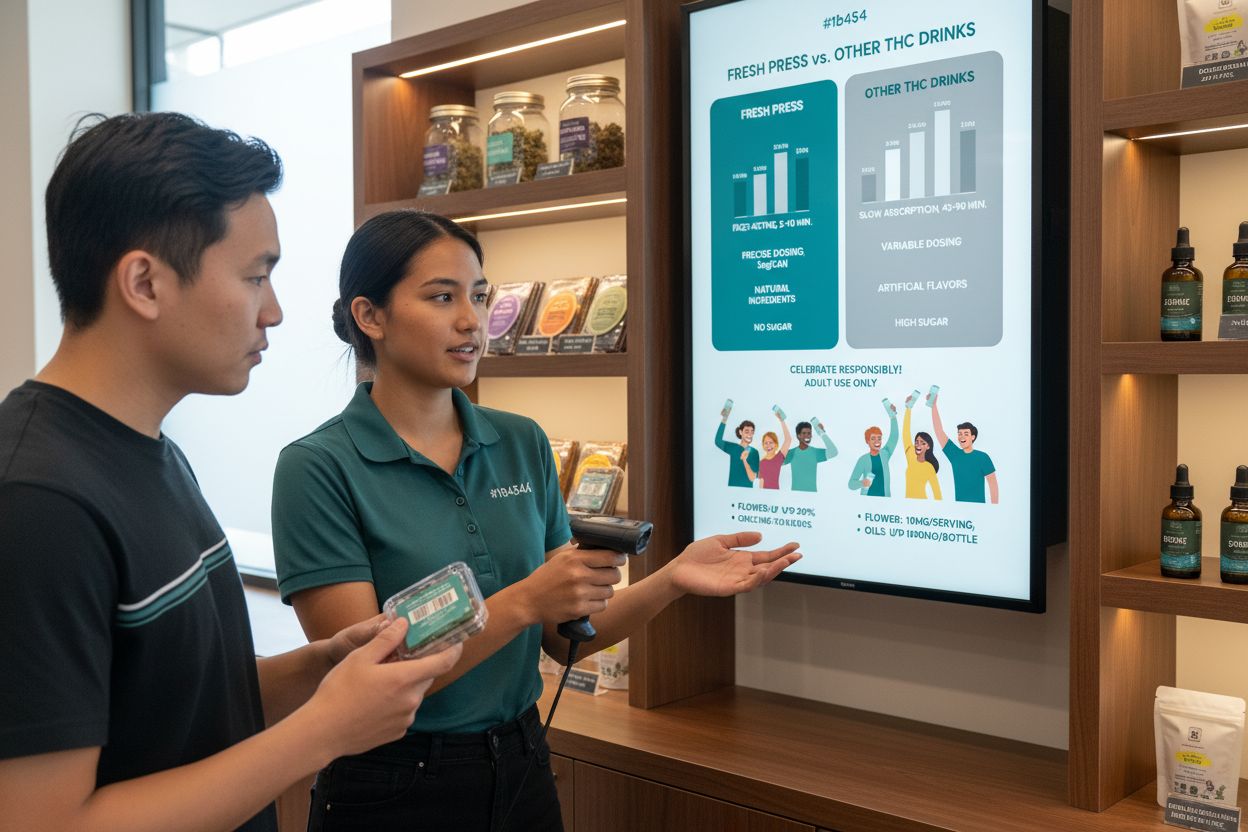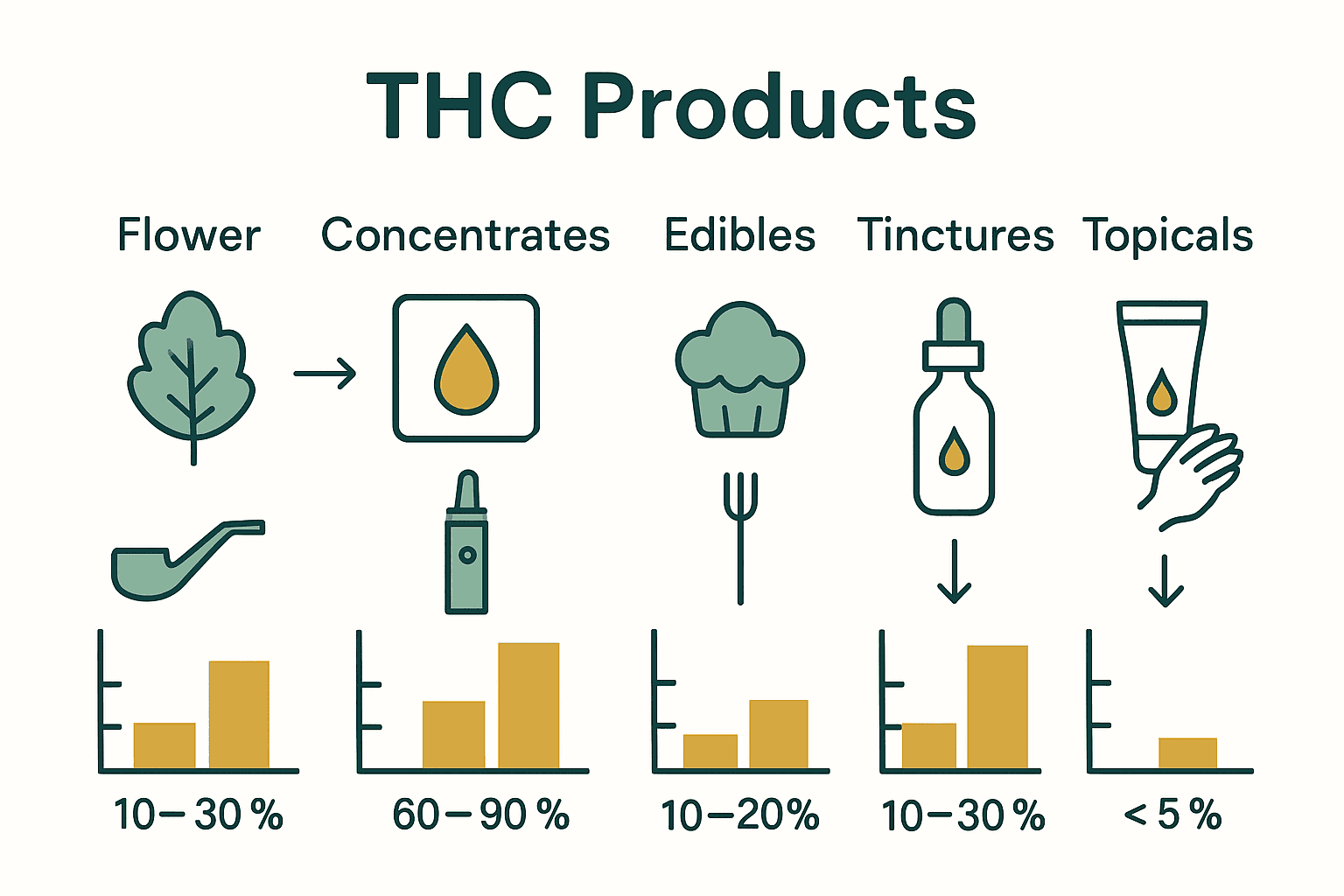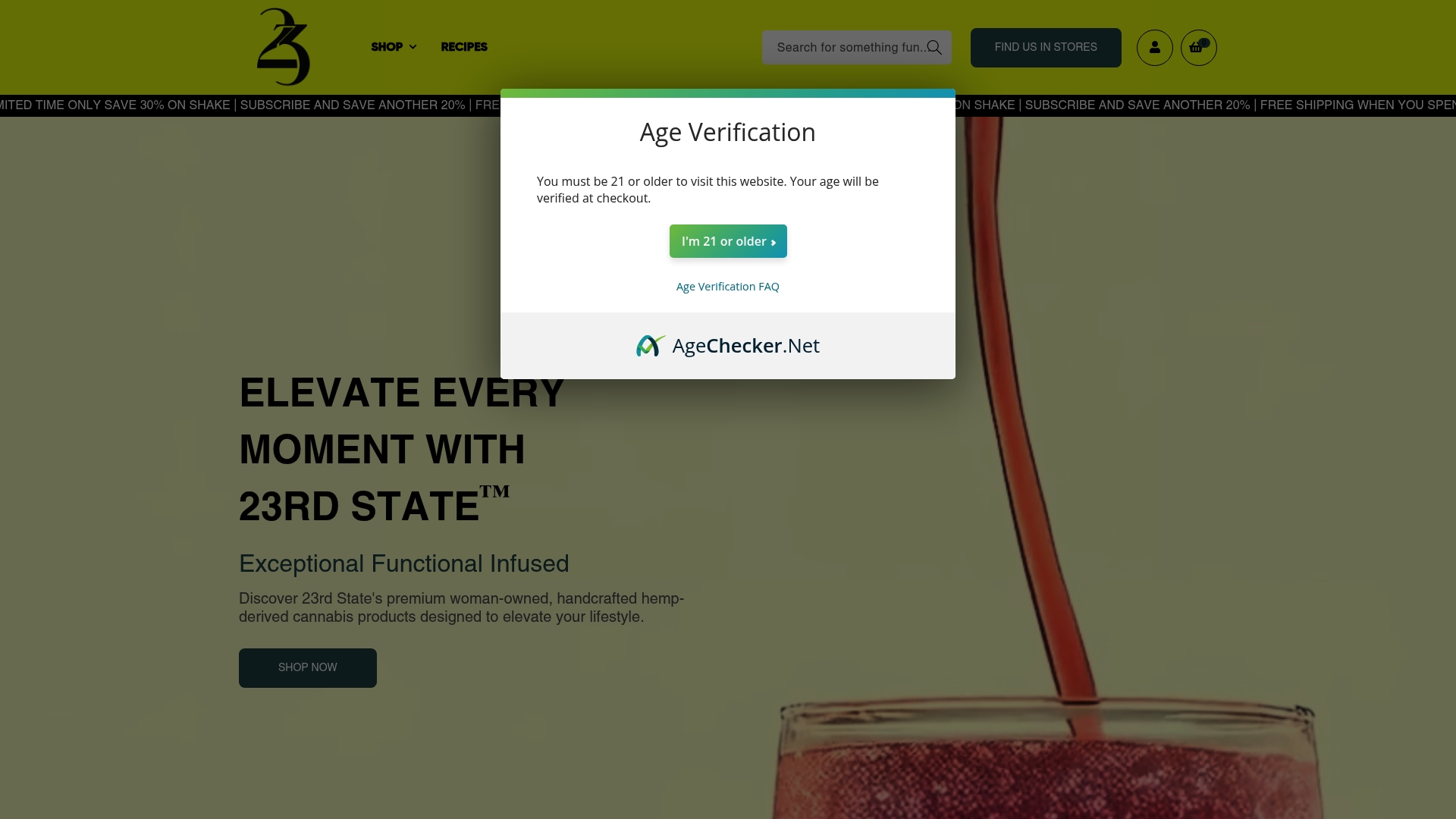Over 40 million Americans have tried cannabis, yet many remain confused about what THC limits are actually legal across the U.S. With state and federal rules constantly changing, understanding THC regulations matters for health, safety, and legal peace of mind. This overview untangles the facts so you can navigate product choices, local laws, and your rights as a consumer with clarity and confidence.
Key Takeaways
| Point | Details |
|---|---|
| Varied THC Regulations | THC legal limits differ greatly by state, with common serving sizes ranging from 5 mg to 10 mg and total package limits between 50-100 mg. |
| Federal vs. State Tensions | Federal proposals may standardize THC limits, but states retain the power to impose stricter regulations, leading to a confusing marketplace. |
| Diverse THC Product Types | THC products include flowers, concentrates, edibles, tinctures, and topicals, each with varying concentrations and effects, necessitating informed consumer choices. |
| Consumer Awareness is Crucial | Understanding state laws and staying updated on legislative changes is essential for safe purchasing and consumption of THC products. |
Table of Contents
- Defining Legal Limit Thc In The U.S.
- Federal Vs. State Thc Regulations
- Types Of Thc Products And Variations
- Consumer Rights, Restrictions, And Compliance
- Risks, Penalties, And Safe Purchasing Tips
Defining Legal Limit THC in the U.S.
Understanding the legal limit for THC in the United States requires navigating a complex landscape of state-specific regulations and federal guidelines. Unlike alcohol, where standard limits are universally recognized, THC regulations vary dramatically across different jurisdictions.
According to research published in the Journal of the National Cancer Institute Monographs, most U.S. states with adult-use cannabis have established clear serving-size limits for consumable products. Typical THC serving limits include:
- 5 mg THC per serving in states like Alaska, Oregon, Massachusetts, and Vermont
- 10 mg per serving in several other states
- Package limits generally ranging between 50-100 mg THC total
Some states go further by implementing strict concentration caps. Vermont, for instance, limits cannabis flower to 30% THC and oils to 60% THC, demonstrating the nuanced approach to regulating cannabis products.

Check out our comprehensive guide on THC regulations to dive deeper into these intricate legal frameworks.
Navigating these regulations requires consumers to stay informed about their specific state’s guidelines. While federal law still classifies cannabis as a controlled substance, state-level policies continue to evolve, creating a dynamic and sometimes confusing landscape for cannabis enthusiasts and wellness-focused consumers.
Federal vs. State THC Regulations. The landscape of THC regulations in the United States is a complex and evolving terrain, where federal guidelines and state-level policies frequently clash and create significant legal uncertainty. The ongoing tension between national and local regulatory approaches continues to challenge both consumers and industry professionals.
According to recent reporting from Reuters, federal authorities are considering significant regulatory shifts. Congress has proposed a pivotal 2025 spending bill that would redefine hemp regulations, potentially limiting combined THC (including THCA and its isomers) to a strict ≤0.3% threshold. This proposed legislation could effectively outlaw many currently available intoxicating hemp-derived products, marking a substantial potential change in the cannabis marketplace.
Key aspects of the current federal vs. state regulatory environment include:
- States retain autonomous power to impose stricter restrictions or complete bans on hemp products
- The Farm Bill provides a framework allowing individual states significant regulatory flexibility
- Federal proposals aim to standardize THC concentration limits across different product categories
Explore the intricate legal landscape of THC beverages to understand how these regulatory nuances impact product availability and consumer choices. Courts have consistently affirmed states’ authority to implement more stringent controls, creating a patchwork of regulations that can vary dramatically from one jurisdiction to another.
For consumers and industry stakeholders, staying informed about these dynamic regulatory shifts is crucial. The ongoing dialogue between federal legislators and state-level policymakers suggests that the THC regulatory environment will continue to evolve, potentially reshaping the accessibility and legal status of hemp-derived products in the coming years.
Types of THC Products and Variations
The world of THC products is incredibly diverse, offering consumers a wide range of consumption methods and potency levels. From traditional flower to advanced concentrates, the cannabis market has evolved dramatically, providing options for every preference and experience level.
According to research from Wikipedia, cannabis concentrates represent a significant advancement in product innovation. These extracts are substantially more potent than traditional marijuana, with THC concentrations ranging dramatically from 40% to 90%. In comparison, high-grade marijuana typically contains around 20% THC, making concentrates a much more intense option for experienced consumers.
Key THC product variations include:
- Flower: Traditional cannabis buds with moderate THC levels
- Concentrates: Highly potent extracts sold in small containers
- Edibles: Food and drink products infused with THC
- Tinctures: Liquid extracts taken sublingually
- Topicals: Non-psychoactive products applied directly to the skin
Learn more about the nuanced differences between THC variants, particularly how hash oil demonstrates remarkable potency variations. Historical data shows hash oil THC concentrations have evolved from 10%–30% in earlier products to approximately 90% in contemporary formulations, highlighting the rapid technological advancements in cannabis extraction methods.
Understanding these product variations is crucial for responsible consumption. Each product type offers unique onset times, duration of effects, and intensity levels, allowing consumers to select options that best match their wellness goals and personal preferences.

Here’s a comparison of key THC product types:
| Product Type | Typical THC Concentration | Consumption Method | Common Effects |
|---|---|---|---|
| Flower | ~15-25% | Smoking Vaporizing |
Moderate, Balanced High |
| Concentrates | 40-90% | Dabbing Vaporizing |
Intense, Fast Onset |
| Edibles | 5-10 mg/serving (varies) | Eating/Drinking | Delayed, Long-lasting |
| Tinctures | Varies, often potent | Sublingual (under tongue) | Controlled, Moderate |
| Topicals | Trace to none | Topical application | Non-psychoactive relief |
Consumer Rights, Restrictions, and Compliance
Navigating the consumer landscape for THC products requires a nuanced understanding of rapidly evolving legal frameworks and state-specific regulations. The current marketplace presents a complex tapestry of rights, restrictions, and compliance challenges that demand careful consumer awareness.
According to recent reporting from Reuters, the regulatory environment is dramatically shifting. At least 32 states have implemented distinctly different approaches to hemp-derived THC products, ranging from tightly regulated sales to outright bans. States like California, Virginia, and Arkansas have been particularly proactive, enacting strict restrictions and bans on intoxicating hemp-derived THC products, with courts consistently upholding these state-level regulations.
Key consumer considerations include:
- Understanding individual state-specific THC product regulations
- Verifying age and purchase restrictions
- Checking product compliance with local legal standards
- Monitoring ongoing legislative changes
- Maintaining awareness of potential legal shifts
Discover comprehensive insights about local THC regulations to ensure you’re making informed purchasing decisions. Federal efforts continue to close existing Farm Bill loopholes, suggesting that the regulatory landscape will remain dynamic and potentially restrictive in the coming years.
For consumers, staying informed is not just recommended—it’s essential. The ongoing battle between federal regulators and state-level policymakers means that today’s legal product could potentially become restricted tomorrow, underscoring the importance of continuous education and regulatory awareness.
Risks, Penalties, and Safe Purchasing Tips
The landscape of THC consumption involves complex legal and personal safety considerations that every responsible consumer must understand. Navigating potential risks requires a comprehensive approach to purchasing, consuming, and managing THC products.
Research from medical journals reveals critical insights into legal limitations and safety parameters. Several states like Colorado, Montana, and Nevada have established strict per se legal THC blood limits for driving, typically set around 5 µg/L. These regulations underscore the importance of understanding how THC can impact your ability to operate vehicles and engage in potentially dangerous activities.
Key safety and legal considerations include:
- Understand state-specific driving limit regulations
- Check personal tolerance and consumption limits
- Purchase only from licensed, verified retailers
- Store products securely away from minors
- Be aware of potential workplace restrictions
- Avoid consuming before operating machinery
Explore safe online purchasing strategies for THC products to minimize legal risks. Medical cannabis possession limits demonstrate the complexity of regulation, with research showing variations from 1.5 g to 762 g of pure THC per 30-day period. Given that typical medical doses are around 5 mg THC, these ranges can represent hundreds to tens of thousands of potential doses.
Responsible consumption is about more than legal compliance—it’s about personal health, safety, and understanding your own limits. Always prioritize purchasing from reputable sources, start with low doses, and remain informed about evolving regulations in your specific jurisdiction.
Ready to Shop Legally and Confidently for THC and Hemp Products?
If the legal complexities highlighted in our guide have left you feeling cautious about your next hemp or THC purchase, you are not alone. Navigating shifting legal limits, unclear product labeling, and state-specific rules is stressful. You want compliance, safety, and the best THC or CBG-infused experience—without fear of penalties or uncertainty. That is exactly why our platform exists. At 23state.com, every product meets strict regulatory standards so you can enjoy wellness and lifestyle enhancements with zero guesswork.

Take control of your wellness journey today. Explore our THC and hemp-infused selection and see how compliance meets premium quality. Take advantage of current promos like free shipping or first-time discounts so you can purchase with peace of mind. Stay ahead of confusing regulations and make sure your next choice is both legal and rewarding. Visit 23state.com now and step confidently into the next evolution of cannabis enjoyment.
Frequently Asked Questions
What is the legal limit for THC in the United States?
The legal limit for THC varies by state, with typical serving sizes ranging from 5 mg to 10 mg per serving for consumable products. Some states have established package limits ranging from 50 mg to 100 mg total THC.
How do THC concentrations differ between product types?
THC concentrations vary significantly: traditional flower contains about 15-25% THC, while concentrates can range from 40% to 90%. Edibles usually contain around 5-10 mg per serving, while tinctures can vary greatly in potency.
What should consumers be aware of regarding THC consumption limits?
Consumers should understand their state’s THC regulations, including age restrictions, purchase limits, and potential legal penalties associated with THC consumption. Being informed about driving limits and personal tolerance is also essential for safety.
What are the different types of THC products available?
Different types of THC products include flower (buds), concentrates (potent extracts), edibles (food infused with THC), tinctures (liquid extracts), and topicals (non-psychoactive products for skin application). Each type offers unique effects and consumption methods.

